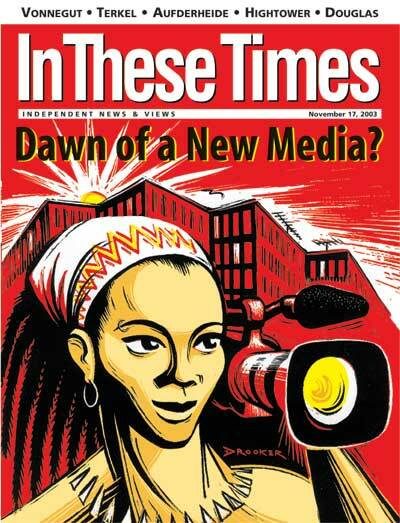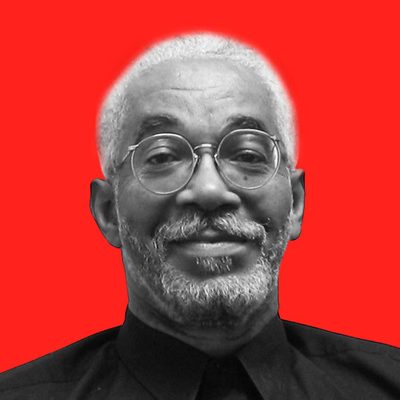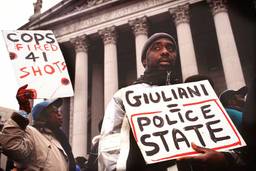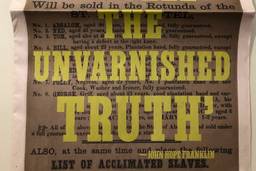The fight to contain the monopolistic impulses of the corporate media has galvanized media activists. Their efforts have borne some fruit, mobilizing considerable opposition to a Federal Communications Commissions ruling that loosens limits on the number of stations a single company may own. On September 17 the Senate passed a full rollback of the FCC ruling.
But this sharp, almost exclusive focus on corporate ownership has drowned out other crucial concerns in the struggle for media democracy. And one of the most serious issues is the continuing problem of racial bias.
Many of our current headlines are suffused with racial content. But there’s precious little effort to place that content in an understandable context. The long line of statistics that point to continuing racial inequities—in health care, incarceration, poverty, education, employment and more—are often marginalized as aberrations in a land of opportunity.
There is a “race fatigue” factor in much mainstream media coverage these days. The media message to African Americans is this: Racism is old news—get over it.
Rush Limbaugh was essentially fired for saying on air that the media was giving black NFL quarterback Donovan McNabb a pass because it was “very desirous that a black quarterback do well.” His comments were troubling more for the context of his words than the content. He was hired by ESPN to attract white males (“NASCAR Dads”) similarly offended by affirmative action. Limbaugh’s argument feeds the notion that an unbridled beast of affirmative action is roaming the countryside, victimizing helpless whites.
This animus against affirmative action is part of a general American narrative of racial hierarchy and privilege. It’s an old narrative with many subplots and subtleties (Confederate patriots thought that freeing slaves was “affirmative action”), but the overall theme is white supremacy.
An important part of the media’s job during America’s formative years was to transform racial hierarchy into conventional wisdom. Their success was overwhelming.
Racist assumptions have blocked African-American progress at every historical juncture, but these biases are so deeply embedded in U.S. institutions and attitudes that most of the white Americans who share them often can’t detect them. Distressingly, these notions can also be found in some progressive quarters. The history of this nation’s progressive movement is rife with racial rancor. And although progressives have more openly confronted racial issues than other spheres of society in America, they still have a lot of work to do—just look at the leadership ranks of progressive organizations.
That may be one reason why the movement for media democracy, as commendable as it is, has failed to attract the attention of black activists with whom it would seem to have much in common.
“The corporate preoccupations of most white media activists have very little relevance to the everyday lives of the black people I see who are adversely affected by the media on a regular basis,” explains Karen Bond, a black media activist from Evanston, Illinois. Bond says her basic struggle is to reduce media portrayals that promote negative racial stereotypes influencing the life chances of American minorities. “That’s where the rubber really meets the road in the media.” Ownership diversity doesn’t necessarily speak to that core problem, she says. “When media had more diverse ownership, stereotypes still reigned.”
Bond has a point. Media-driven stereotypes tend to drive social policy. I have no doubt that media stereotypes of black criminality help account for the incarceration epidemic afflicting black youth. One of the more recent examples of this correlation showed up in a landmark 2001 study, co-authored by Lori Dorfman of the Berkeley Media Studies Group and Vincent Schiraldi of the Justice Policy Institute.
The study found that media coverage of crime exaggerates its scope and unduly connects it to youth and race, noting that 62 percent of the poll respondents felt juvenile crime was on the increase, although violent crime by youth in 1998 was at its lowest point in more than two decades.
The authors concluded, “In an environment in which fear of youth crime and actual youth crime are so out of sync, policies affecting young people are bound to be impacted.”
And they have been; during this same period, legislators across the country were racing to pass ever more onerous measures to try children as adults or to increase the range of punishment available to youthful offenders.
“A disproportionate number of perpetrators on the news are people of color, especially African Americans,” the authors write. They note that a study of Time and Newsweek stories found that the term “young black males” was synonymous with the word criminal.
These cultural synonyms have helped create a social system of racial disparities in which, according to a report by Human Rights Watch, there are five times more white drug users than black ones, but African Americans are imprisoned at several times the rate of whites.
Even black men who evade prison and seek employment are less likely to find it than white men, according to work by Northwestern University sociologist Devah Pager. Her study found that white applicants with prison records were more likely to be hired than black men without records.
Race bias is still a fact in America, and media too often facilitate it. We are still haunted by notions of racial hierarchy because the United States has yet to confront the complex legacy of slavery. Progressive activists must remind themselves that a true struggle for media democracy demands they continually challenge the conventional wisdom of white supremacy.
But this sharp, almost exclusive focus on corporate ownership has drowned out other crucial concerns in the struggle for media democracy. And one of the most serious issues is the continuing problem of racial bias.
Many of our current headlines are suffused with racial content. But there’s precious little effort to place that content in an understandable context. The long line of statistics that point to continuing racial inequities—in health care, incarceration, poverty, education, employment and more—are often marginalized as aberrations in a land of opportunity.
There is a “race fatigue” factor in much mainstream media coverage these days. The media message to African Americans is this: Racism is old news—get over it.
Rush Limbaugh was essentially fired for saying on air that the media was giving black NFL quarterback Donovan McNabb a pass because it was “very desirous that a black quarterback do well.” His comments were troubling more for the context of his words than the content. He was hired by ESPN to attract white males (“NASCAR Dads”) similarly offended by affirmative action. Limbaugh’s argument feeds the notion that an unbridled beast of affirmative action is roaming the countryside, victimizing helpless whites.
This animus against affirmative action is part of a general American narrative of racial hierarchy and privilege. It’s an old narrative with many subplots and subtleties (Confederate patriots thought that freeing slaves was “affirmative action”), but the overall theme is white supremacy.
An important part of the media’s job during America’s formative years was to transform racial hierarchy into conventional wisdom. Their success was overwhelming.
Racist assumptions have blocked African-American progress at every historical juncture, but these biases are so deeply embedded in U.S. institutions and attitudes that most of the white Americans who share them often can’t detect them. Distressingly, these notions can also be found in some progressive quarters. The history of this nation’s progressive movement is rife with racial rancor. And although progressives have more openly confronted racial issues than other spheres of society in America, they still have a lot of work to do—just look at the leadership ranks of progressive organizations.
That may be one reason why the movement for media democracy, as commendable as it is, has failed to attract the attention of black activists with whom it would seem to have much in common.
“The corporate preoccupations of most white media activists have very little relevance to the everyday lives of the black people I see who are adversely affected by the media on a regular basis,” explains Karen Bond, a black media activist from Evanston, Illinois. Bond says her basic struggle is to reduce media portrayals that promote negative racial stereotypes influencing the life chances of American minorities. “That’s where the rubber really meets the road in the media.” Ownership diversity doesn’t necessarily speak to that core problem, she says. “When media had more diverse ownership, stereotypes still reigned.”
Bond has a point. Media-driven stereotypes tend to drive social policy. I have no doubt that media stereotypes of black criminality help account for the incarceration epidemic afflicting black youth. One of the more recent examples of this correlation showed up in a landmark 2001 study, co-authored by Lori Dorfman of the Berkeley Media Studies Group and Vincent Schiraldi of the Justice Policy Institute.
The study found that media coverage of crime exaggerates its scope and unduly connects it to youth and race, noting that 62 percent of the poll respondents felt juvenile crime was on the increase, although violent crime by youth in 1998 was at its lowest point in more than two decades.
The authors concluded, “In an environment in which fear of youth crime and actual youth crime are so out of sync, policies affecting young people are bound to be impacted.”
And they have been; during this same period, legislators across the country were racing to pass ever more onerous measures to try children as adults or to increase the range of punishment available to youthful offenders.
“A disproportionate number of perpetrators on the news are people of color, especially African Americans,” the authors write. They note that a study of Time and Newsweek stories found that the term “young black males” was synonymous with the word criminal.
These cultural synonyms have helped create a social system of racial disparities in which, according to a report by Human Rights Watch, there are five times more white drug users than black ones, but African Americans are imprisoned at several times the rate of whites.
Even black men who evade prison and seek employment are less likely to find it than white men, according to work by Northwestern University sociologist Devah Pager. Her study found that white applicants with prison records were more likely to be hired than black men without records.
Race bias is still a fact in America, and media too often facilitate it. We are still haunted by notions of racial hierarchy because the United States has yet to confront the complex legacy of slavery. Progressive activists must remind themselves that a true struggle for media democracy demands they continually challenge the conventional wisdom of white supremacy.
Salim Muwakkil is a senior editor of In These Times and host of “The Salim Muwakkil Show” on radio station WVON-AM in Chicago. Muwakkil was also contributing columnist for both the Chicago Sun-Times (1993 – 1997) and the Chicago Tribune (1998 – 2005). He is also a co-founder of Pacifica News’ network daily “Democracy Now” program and served as an adjunct professor at Northwestern University, University of Illinois, the Art Institute of Chicago and Chicago’s Columbia College.









